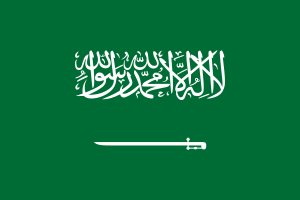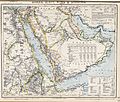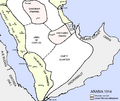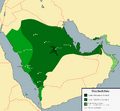History of Saudi Arabia facts for kids
Settlements have always existed around oases. These are special places in the desert where plants can grow and water is available.
Saudi Arabia became a very important center when Islam began in the 620s. The cities of Medina and Mecca became the holiest places in Islam. They are still the two holiest cities for Muslims around the world. The rulers and kings of Saudi Arabia also gained more power during this time.
Contents
Modern History of Saudi Arabia
How Saudi Arabia Began
The modern history of Saudi Arabia started in 1744. An Islamic reformer named Muhammad ibn Abd al-Wahhab and a local ruler named Muhammad bin Saud Al Muqrin worked together. They founded the Saudi state in the central part of the Arabian Peninsula.
Over the next 150 years, the Saud family had good times and bad times. They faced challenges from rulers of Egypt and the Ottoman Empire. Other powerful families in Arabia also opposed them.
Finally, after many years, the modern state of Saudi Arabia was established. This was done by King Abdul Aziz Al-Saud. In 1902, he took control of the city of Riyadh from another family called Al-Rashid. He continued to win more areas.
On January 8, 1926, he became the King of Hijaz. Then, on January 29, 1927, he took the title of King of Nejd. The government of the United Kingdom recognized him as the ruler of these areas on May 20, 1927. His kingdom became a sovereignty, meaning it was an independent country. All the regions he controlled were united to form the state of Saudi Arabia by 1932.
A very important event happened on March 3, 1938. Petroleum oil was found in Saudi Arabia! This discovery made the country very rich. Exporting oil started to bring in a lot of money.
Setting the Borders
From the early 1920s, Saudi Arabia talked with its neighbors about setting clear borders. It finalized its borders with Iraq, Jordan, and Kuwait. Two special "neutral zones" were created on the borders with Iraq and Kuwait. These zones were shared areas. In 1934, borders with Yemen were mostly finalized.
In 1965, Saudi Arabia and Jordan exchanged some land to make their borders better. In 1971, the neutral zone between Saudi Arabia and Kuwait was divided between them. Similarly, Saudi Arabia and Iraq decided in 1981 to divide their neutral zone. This division happened in 1984.
However, Saudi Arabia's borders with the United Arab Emirates and Oman are still not fully final. The border with Qatar was finalized in 2001.
Saudi Politics and Kings
King Abdul Aziz Al-Saud passed away in 1953. His son, Saud, became the next king. He ruled for 11 years. In 1964, he had to step down. His half-brother, Faisal, then became king. Faisal had the support of the royal family and religious leaders.
King Faisal also held the job of Prime Minister. This tradition of the King also being the Prime Minister continues in Saudi Arabia today. All kings after Faisal have followed this practice.
Faisal made many new plans for Saudi Arabia's economic development. During his time, several important political events took place:
- Differences over Yemen: Egypt supported a new government in Yemen. Saudi Arabia, however, supported the royal family of Yemen to stay in power.
- The Six-Day War of 1967: Saudi Arabia did not fight directly in this war. But after the war, it gave financial help to Egypt, Syria, and Jordan.
- Stopping oil supply: In 1973, many countries stopped supplying petroleum oil to the USA and the Netherlands. Saudi Arabia was one of these countries.
In 1975, King Faisal was assassinated by one of his nephews. The nephew was found guilty and was sentenced to death. King Faisal's half-brother, Khalid, became the King and Prime Minister. During King Khalid's rule, Saudi Arabia became more important in regional politics. The country's economy also continued to grow well.
King Fahd's Time
King Khalid died in 1982. After his death, Fahd became the King and Prime Minister. His half-brother, Prince Abdullah, became the Crown Prince.
During King Fahd's rule, Saudi Arabia's income decreased. This was because the price of petroleum oil went down. King Fahd's government used an economic plan that helped the country manage with less income.
King Fahd helped Iraq during the Iran–Iraq War. Iraq's economy was badly affected by this war. The King also talked with both Iran and Iraq to help them stop the war. Both countries stopped fighting in August 1988. King Fahd also helped make the Gulf Cooperation Council (GCC) stronger. The GCC is a group of six countries in the Persian Gulf. Its goal is to increase development and cooperation among its members.
The Gulf War
In 1990, Saddam Hussain was the ruler of Iraq. He invaded Kuwait, which led to the Gulf War in 1991. Many people worried that his army would also invade Saudi Arabia. King Fahd allowed some Western countries and the USA to send their forces to Saudi Arabia. Many Muslims were upset that their holy land was being used by non-Muslim soldiers.
King Fahd played a very important role during and after the Gulf War. During the war, he allowed the royal family of Kuwait to stay in Saudi Arabia. About 400,000 other people from Kuwait also came to stay temporarily. The King allowed troops from countries like the USA to launch attacks from Saudi Arabia to free Kuwait. He also helped get support from other Muslim countries to free Kuwait. Eventually, Iraqi forces were forced out of Kuwait.
Dealing with Terrorism
The presence of troops from Western countries angered many Muslims. One of them was a rich man named Osama bin Laden. He was forced to leave Saudi Arabia because he disagreed with and opposed the King. Besides Osama bin Laden and his groups, several other people and groups did not like Western troops in Saudi Arabia.
These people and groups attacked others. They mainly tried to attack foreign troops in Saudi Arabia. Here are some examples of such attacks:
- A truck bomb killed 19 USA troops in June 1996.
- A base of the Saudi National Guard was bombed in November 1995.
The September 11, 2001 attacks in New York caused many deaths and huge destruction. After an investigation, it was found that 15 out of 19 suspected people for these attacks were from Saudi Arabia.
Such events caught the attention of the Saudi Arabian government. The government started a plan to stop these activities. Even so, terrorist activities by these people and groups continued for some time.
Saudi Arabia Today
- Death of King Fahd: He died in July 2005. After his death, his brother, Prince Abdullah, became the king.
- Death of King Abdullah: In 2015, King Abdullah died due to sickness. His half-brother, Prince Salman, became king.
- An Oil Hub: Saudi Arabia has the world's largest oil reserves. The government is putting a lot of effort into developing its infrastructure, science, and technology. Many economists and experts believe that Saudi Arabia is becoming a leading country in the Middle East.
Related pages
Images for kids
-
The tribes of Arabia at the time of the spread of Islam (expandable map)
-
The first Saudi State 1744–1818
-
Abdulaziz Al Saud, founder of Saudi Arabia
See also
 In Spanish: Historia de Arabia Saudita para niños
In Spanish: Historia de Arabia Saudita para niños









